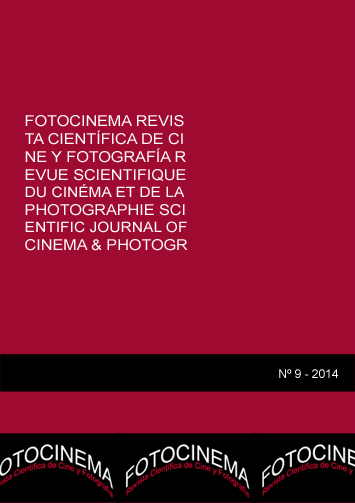Lo que Miyazaki nos quiso decir. Ecologismo y hermenéutica detrás de Mononoke Hime
DOI:
https://doi.org/10.24310/Fotocinema.2014.v0i9.5967Abstract
Los desastres de Hiroshima y Nagasaki supusieron para la sociedad japonesa un cambio de estructura tanto en sus formas de pensamiento como de expresión cultural. El miedo histórico hacia Occidente, consumado con la derrota militar, la tecnificación exacerbada, y, sobre todo, una hipotética hecatombe nuclear, se erigieron en puntos clave para entender las nuevas temáticas narrativas aparecidas en el solaz nipón; géneros cinematográficos como el kaiju, el renacimiento del kaidan, o la proliferación de historias con marcada tendencia ecologista, no hacen sino atestiguar los cambios de un Japón nuevo, esencialmente diferente, por fuerza, al de la anterior era Showa.Explicar y razonar qué es el “Tercer Impacto” y utilizarlo para diseccionar La Princesa Mononoke, serán los objetivos de este artículo. Pondremos en valor nuevos conceptos como el ambientalismo mágico, analizaremos el papel del héroe, de las mujeres, o de los animales, además de establecer relaciones entre la mentalidad nipona y los hitos representativos del Maestro Hayao Miyazaki. Con ello asumiremos rasgos esenciales del Japón moderno y tradicional por medio de un film que, si bien ha sido eclipsado por la oscarizada El viaje de Chihiro, se erige en el principal exponente de una forma muy concreta de entender el Cine.
Abstract:
Hiroshima and Nahasaki disasters meant a structural change for Japanese society, not only related to ways of thinking but also respecting cultural manifestations. Historical fear towards Western society along with military defeats, massive technification, and, last but not least, a hypothetical nuclear catastrophe were basic factors to understand the rise of new narrative themes in the japanese territory. Cinematographic genres such as kaiju, the rebirth of kaidan or the proliferation of ecology-based stories are a solid testimony of this New Japan, necessarily different to the one of the previous era, Showa.
The objectives of this communication are to explain and reason what was the “Third Impact” and use this knowledge to dissection Princess Mononoke. We will come across new concepts, as magic environmentalism and analyze the role of the hero, the animals and women. Besides, we will make connections with japanese mindset and relate it to other Master Hayao Miyazaki hits. In doing so, we will take over some essential traits of modern Japan through this film, which may have been outshined by the multi-awarded Spirited Away, but still is the key sample of a very peculiar way to understand cinema.
Palabras clave:
Tercer Impacto; Hayao Miyazaki; tecnología; ecologismo.
Keywords:
Third Impact; Hayao Miyazaki; Technology; Ecologism.Downloads
Metrics
Publication Facts
Reviewer profiles N/A
Author statements
Indexed in
-
—
- Academic society
- N/A
- Publisher
- Universidad de Málaga
Downloads
Published
How to Cite
Issue
Section
License
All contents published in Fotocinema Revista científica de cine y fotografía are protected under the Creative Commons Attribution-NonCommercial-ShareAlike 4.0 International (CC BY-NC-SA 4.0) license. All about this license is available in the following link: <http://creativecommons.org/licenses/by-nc-sa/4.0>
Users can copy, use, redistribute, share and exhibit publicly as long as:
- The original source and authorship of the material are cited (Journal, Publisher and URL of the work).
- It is not used for comercial purposes.
- The existence of the license and its especifications are mentioned.
There are two sets of authors’ rights: moral and property rights. Moral rights are perpetual prerogatives, unrenounceable, not-transferable, unalienable, imprescriptible and inembargable. According to authors’ rights legislation, Fotocinema. Revista científica de cine y fotografía recognizes and respects authors moral rights, as well as the ownership of property rights, which will be transferred to University of Malaga in open access. The property rights are referred to the benefits that are gained by the use or the dissemination of works. Fotocinema. Revista científica de cine y fotografía is published in an open access form and it is exclusively licenced by any means for doing or authorising distribution, dissemination, reproduction, , adaptation, translation or arrangement of works.
Authors are responsable for obtaining the necessary permission to use copyrighted images.














13.png)



